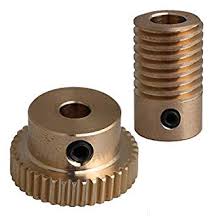The steel is employed for high strength worm gears (worm wheel) and steel may be plain carbon steel or alloy steel. The metal gears are often heat treated to be able to combine properly the toughness and tooth hardness.
The phosphor bronze is widely used for worms drive so as to reduce wear of the worms which is excessive with cast iron or steel.
Worm gear units are usually used to lessen speed and maximize torque. Because the worm travel undergoes more contact stress cycles than the worm equipment, the worm travel is often of a stronger material.
• Cast iron provides durability and simple manufacture.
• Cast steel provides a lot easier fabrication, strong operating loads and vibration level of resistance.
• Carbon steels are inexpensive and good, but are vunerable to corrosion.
• Aluminum is utilized when low equipment inertia with some resiliency is necessary.
• Brass is inexpensive, easy to mold and corrosion tolerant.
• Copper is easily shaped, conductive and corrosion resistant. The gear’s strength would maximize if bronzed.
• Plastic is inexpensive, corrosion resistant, quiet operationally and may overcome missing tooth or misalignment. Plastic-type is fewer robust than steel and is vulnerable to temperature changes and chemical substance corrosion. Acetal, delrin, nylon, and polycarbonate plastics are common.
This 27 tooth brass worm gear is intended to be used with a worm gear to produce a 27:1 reduction in speed while also changing the orientation of the rotating axis by 90 degrees. This equipment fastens to a 1/4″ shaft using a specialised 1/4″ D-hub to be utilized with 1/4″ D-shaft.
The manufacturing ways of worms are roughly divided among cutting, heat treated and ground after cutting and rolling. And  for worm wheels, they might be approximately divided among cutting tooth, cutting the teeth after casting, and the teeth cutting after the exterior rim is normally cast around the center of the blank.
for worm wheels, they might be approximately divided among cutting tooth, cutting the teeth after casting, and the teeth cutting after the exterior rim is normally cast around the center of the blank.